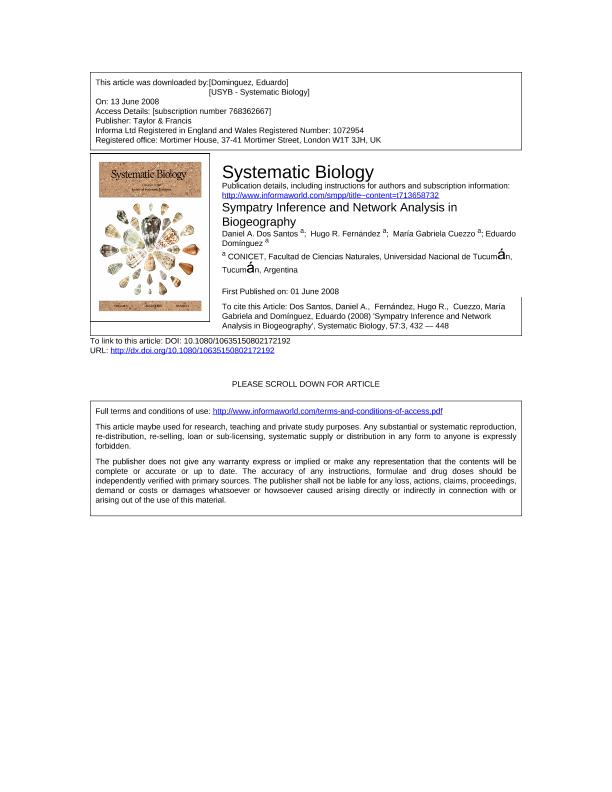Mostrar el registro sencillo del ítem
dc.contributor.author
Dos Santos, Daniel Andrés

dc.contributor.author
Fernandez, Hugo Rafael

dc.contributor.author
Cuezzo, Maria Gabriela

dc.contributor.author
Dominguez, Eduardo

dc.date.available
2021-09-24T19:43:32Z
dc.date.issued
2008-06
dc.identifier.citation
Dos Santos, Daniel Andrés; Fernandez, Hugo Rafael; Cuezzo, Maria Gabriela; Dominguez, Eduardo; Sympatry inference and network analysis in biogeography; Oxford University Press; Systematic Biology; 57; 3; 6-2008; 432-448
dc.identifier.issn
1063-5157
dc.identifier.uri
http://hdl.handle.net/11336/141515
dc.description.abstract
A new approach for biogeography to find patterns of sympatry, based on network analysis, is proposed. Biogeographic analysis focuses basically on sympatry patterns of species. Sympatry is a network (= relational) datum, but it has never been analyzed before using relational tools such as Network Analysis. Our approach to biogeographic analysis consists of two parts: first the sympatry inference and second the network analysis method (NAM). The sympatry inference method was designed to propose sympatry hypothesis, constructing a basal sympatry network based on punctual data, independent of a priori distributional area determination. In this way, two or more species are considered sympatric when there is interpenetration and relative proximity among their records of occurrence. In nature, groups of species presenting within-group sympatry and between-group allopatry constitute natural units (units of co-occurrence). These allopatric units are usually connected by intermediary species. The network analysis method (NAM) that we propose here is based on the identification and removal of intermediary species to segregate units of co-occurrence, using the betweenness measure and the clustering coefficient. The species ranges of the units of co-occurrence obtained are transferred to a map, being considered as candidates to areas of endemism. The new approach was implemented on three different real complex data sets (one of them a classic example previously used in biogeography) resulting in (1) independence of predefined spatial units; (2) definition of co-occurrence patterns from the sympatry network structure, not from species range similarities; (3) higher stability in results despite scale changes; (4) identification of candidates to areas of endemism supported by strictly endemic species; (5) identification of intermediary species with particular biological attributes. Copyright © Society of Systematic Biologists.
dc.format
application/pdf
dc.language.iso
eng
dc.publisher
Oxford University Press

dc.rights
info:eu-repo/semantics/openAccess
dc.rights.uri
https://creativecommons.org/licenses/by-nc-sa/2.5/ar/
dc.subject
BETWEENNESS
dc.subject
CLUSTERING COEFFICIENT
dc.subject
DOT MAPS
dc.subject
HISTORICAL BIOGEOGRAPHY
dc.subject
INTERMEDIARY SPECIES
dc.subject
UNITS OF CO-OCCURRENCE
dc.subject.classification
Biología

dc.subject.classification
Ciencias Biológicas

dc.subject.classification
CIENCIAS NATURALES Y EXACTAS

dc.title
Sympatry inference and network analysis in biogeography
dc.type
info:eu-repo/semantics/article
dc.type
info:ar-repo/semantics/artículo
dc.type
info:eu-repo/semantics/publishedVersion
dc.date.updated
2021-09-01T13:50:30Z
dc.journal.volume
57
dc.journal.number
3
dc.journal.pagination
432-448
dc.journal.pais
Reino Unido

dc.journal.ciudad
Oxford
dc.description.fil
Fil: Dos Santos, Daniel Andrés. Consejo Nacional de Investigaciones Científicas y Técnicas. Centro Científico Tecnológico Conicet - Tucumán. Instituto de Biodiversidad Neotropical. Universidad Nacional de Tucumán. Facultad de Ciencias Naturales e Instituto Miguel Lillo. Instituto de Biodiversidad Neotropical. Instituto de Biodiversidad Neotropical; Argentina
dc.description.fil
Fil: Fernandez, Hugo Rafael. Consejo Nacional de Investigaciones Científicas y Técnicas. Centro Científico Tecnológico Conicet - Tucumán. Instituto de Biodiversidad Neotropical. Universidad Nacional de Tucumán. Facultad de Ciencias Naturales e Instituto Miguel Lillo. Instituto de Biodiversidad Neotropical. Instituto de Biodiversidad Neotropical; Argentina
dc.description.fil
Fil: Cuezzo, Maria Gabriela. Consejo Nacional de Investigaciones Científicas y Técnicas. Centro Científico Tecnológico Conicet - Tucumán. Instituto de Biodiversidad Neotropical. Universidad Nacional de Tucumán. Facultad de Ciencias Naturales e Instituto Miguel Lillo. Instituto de Biodiversidad Neotropical. Instituto de Biodiversidad Neotropical; Argentina
dc.description.fil
Fil: Dominguez, Eduardo. Consejo Nacional de Investigaciones Científicas y Técnicas. Centro Científico Tecnológico Conicet - Tucumán. Instituto de Biodiversidad Neotropical. Universidad Nacional de Tucumán. Facultad de Ciencias Naturales e Instituto Miguel Lillo. Instituto de Biodiversidad Neotropical. Instituto de Biodiversidad Neotropical; Argentina
dc.journal.title
Systematic Biology

dc.relation.alternativeid
info:eu-repo/semantics/altIdentifier/doi/http://dx.doi.org/10.1080/10635150802172192
dc.relation.alternativeid
info:eu-repo/semantics/altIdentifier/url/https://academic.oup.com/sysbio/article/57/3/432/1664254
Archivos asociados
